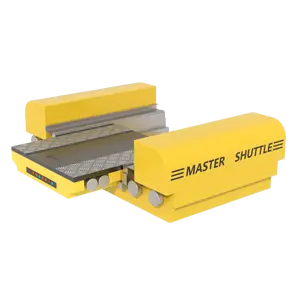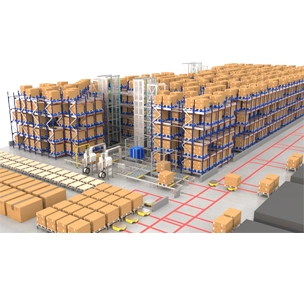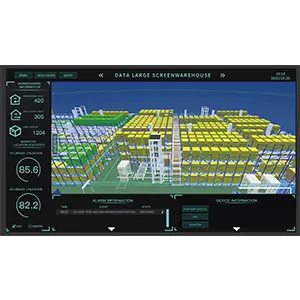Create Time: 05 ,22 ,2025
The demand for efficient, streamlined warehouse operations has never been higher. As global supply chains grow increasingly complex, businesses are turning to advanced solutions to stay competitive. This shift has paved the way for the adoption of ASRS warehouse systems, a game-changing technology transforming how inventory is stored, retrieved, and managed.
Automated Storage and Retrieval Systems (ASRS) are revolutionizing supply chain management by minimizing human intervention, reducing errors, and maximizing space utilization. In this blog, we’ll explore what ASRS is, its benefits, and break down the various types of ASRS systems available to help businesses make informed decisions tailored to their operations.
In its simplest definition, ASRS—or Automated Storage and Retrieval Systems—refers to highly advanced solutions where technology and machinery are used to store and retrieve inventory automatically without human labor. Designed for precision and efficiency, these systems serve warehouses, distribution centers, and manufacturing facilities, enabling optimized workflows and faster order fulfillment.
ASRS systems use a combination of cranes, shuttles, carousels, and robotic modules to store items in designated locations and retrieve them based on demand. They are typically integrated with a Warehouse Management System (WMS) that provides real-time direction to automate these processes.
Space Optimization: ASRS systems maximize vertical storage, drastically increasing capacity within limited footprints.
Labor Efficiency: They reduce dependency on manual labor by automating time-consuming storage and retrieval tasks.
Accuracy: They ensure precise inventory management, reducing the risk of errors.
Speed: Faster operations lead to quicker order fulfillment, which is crucial in industries like e-commerce and retail.
According to recent research, the global ASRS market is projected to reach $11 billion by 2027, reflecting increasing adoption across industries such as logistics, healthcare, and manufacturing.
While ASRS systems vary in design and scale, their core benefits remain consistent across industries:
Improved Space Utilization: Multi-level storage systems maximize warehouse capacity.
Faster Order Picking: Automated processes save time compared to manual labor.
Reduced Errors: Digitized operations minimize picking and inventory errors.
Lower Operating Costs: By reducing labor requirements, ASRS systems lead to long-term cost savings.
Enhanced Productivity: Workers can focus on critical tasks while repetitive activities are automated.
These benefits underscore the growing reliance on ASRS as businesses strive for operational excellence.
When choosing the right ASRS warehouse system, it's essential to understand the different types available. Below is a detailed breakdown:
What is it?
Unit Load ASRS handles large, palletized inventory items using cranes or shuttles for storage and retrieval.
Applications: Ideal for bulk storage or heavy goods that require long-term holding.
Advantages: High storage capacity and reduced handling costs.
Disadvantages: Not suitable for small, lightweight items.
What is it?
Designed for smaller, lighter items, Mini-Load ASRS systems use automated cranes to manage bins, cartons, or totes.
Applications: Commonly used in retail, e-commerce, and electronics industries.
Advantages: Precise storage and quick access to smaller inventory units.
Disadvantages: Limited scalability for larger goods.
What is it?
Vertical Lift Modules are enclosed systems where trays are automatically retrieved based on operator commands.
Applications: Warehouses with limited floor space benefit most from VLMs.
Advantages: Compact design and high ergonomic efficiency.
Disadvantages: Limited customization for high-density inventory.
What is it?
Vertical carousels store and rotate vertically, while horizontal carousels rotate horizontally within the system’s range.
Applications: Suitable for small-to-mid-size warehouses.
Advantages: Simplicity and accessibility for high-turnover inventory.
Disadvantages: Limited capacity compared to other ASRS systems.
What is it?
Highly flexible and intelligent, robotic shuttles move items to and from storage racks with high precision.
Applications: High-density warehouse operations requiring speed and accuracy.
Advantages: Superior scalability and reduced downtime during operations.
Disadvantages: Higher investment costs.
What is it?
AutoStore uses cube-based storage technology to maximize space and enhance order picking efficiency.
Applications: Popular in high-volume environments like e-commerce and logistics.
Advantages: Exceptional space efficiency and cost savings over time.
Disadvantages: Requires compatibility with existing systems.
What is it?
Designed specifically for temperature-controlled environments, ASRS in cold storage integrates machinery that can operate in sub-zero conditions.
Applications: Ideal for managing perishable goods like pharmaceuticals and food.
Advantages: Ensures inventory quality while reducing energy costs.
Disadvantages: Higher upfront investment required for insulated equipment.
When evaluating ASRS options, consider the following factors:
Warehouse Size and Layout: Does the system align with your available space?
Nature of Inventory: Are you handling bulky pallets or smaller goods?
Throughput Requirements: Consider the speed at which items need to be retrieved.
Budget and ROI: Balance upfront costs with long-term benefits.
Scalability: Will the system adapt as your business grows?
For example, e-commerce businesses might benefit from AutoStore systems to handle high SKU counts efficiently, while cold storage facilities may prioritize ASRS systems equipped for low temperatures instead.
E-Commerce and Retail:
ASRS systems enable faster picking for high-volume orders, improving customer satisfaction.
Manufacturing:
Automated storage enhances production workflows by ensuring materials are readily available.
Healthcare:
Accurate storage and retrieval of medical supplies reduce operational errors and improve patient care.
Cold Storage:
Temperature-controlled ASRS ensures the integrity of sensitive goods like food and pharmaceuticals.
The evolution of ASRS technology is poised to shape the future of warehouse automation:
AI Integration: Smart systems capable of predicting inventory needs and optimizing workflows.
IoT Connectivity: Real-time tracking and monitoring of inventory using integrated networks.
Robotics Growth: Increased adoption of robotic shuttles for efficiency.
SMBs Adoption: Affordable options cater to small and medium-sized businesses, expanding the ASRS market.
ASRS warehouse systems are no longer a luxury reserved for large corporations—they have become critical for modern supply chain management. From maximizing space to reducing labor costs, Tianjin MASTER ASRS enables businesses to meet the challenges of today's fast-paced markets.
By choosing the right ASRS system for your business, you can unlock efficiencies, scale operations, and deliver results that drive growth. Ready to automate your warehouse? Contact us today to discover the best ASRS solution for your unique needs!
This is the first one.




